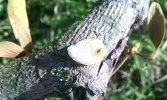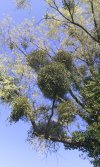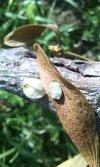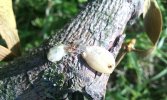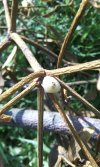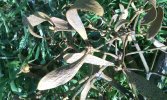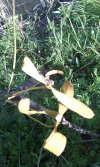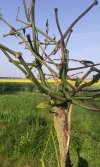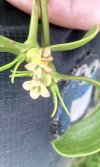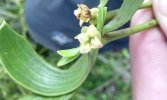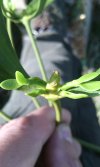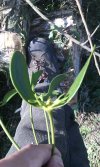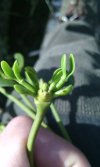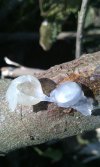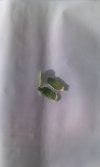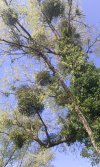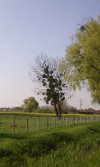zak
The Living Force
You are going to find in this thread several excerpts about the differents possibilities of the mistletoe:
There are still some to follow.
The single success story was mistletoe, which seemed to help the body to 'resocialize' the photon emission of tumor cells back to normal. In one of numerous cases, Popp came across a woman in her thirties with breast and vaginal cancer. Popp tried mistletoe and other plant extracts on samples of her cancerous tissue and found that one particular mistletoe remedy created coherence in the tissue similar to that of the body. With the agreement of her doctor, the woman began forgoing any treatment other than this mistletoe extract. After a year, all her laboratory tests were virtually back to normal. A woman who was given up as a terminal cancer case had her proper light restored, just by taking a herb.2? To Fritz-Albert Popp, homeopathy was another example of photon sucking. He had begun to think of it as a 'resonance absorber'." --- Lynne Mctaggart, The Field - The Quest for the Secret Force of the Universe
"Iscador P contains mistletoe extract from V. pini (mistletoe from pine trees). • Iscador Qu contains mistletoe extract from V. quercus (mistletoe from oak trees). The three types are also available formulated with low concentrations (10~8 g per 100 mg fresh plant extract) of certain metal salts, such as those of copper and mercury. A lectin-standardized extract, also prepared according to the anthroposophic approach, is available, although this formulation does not include metal salts." --- Dr. Michael Heinrich, Joanne Barnes, Simon Gibbons and Elizabeth M. Williamson, Fundamentals of Pharmacognosy and Phytotherapy
"A recent study shows that mistletoe can induce a condition known as eosinophilic (an increase in the number of eosinophils, a type of white blood cell) in healthy adults. [Journal Society Integrative Oncology 4: 3-7, 2006] mistletoe extract has been shown to reduce adverse effects of radiotherapy and chemotherapy on the microcirculation and the immune system of cancer patients. [Anticancer Research 25:601-10, 2005] Iscador is popular in Germany where it was recently shown to improve survival (slightly) among malignant melanoma patients. --- Bill Sardi, You Don't Have to be Afraid of Cancer Anymore
"Disch Med Wochenschr 125: 1222-26, 2000] A study of patients who had undergone bladder cancer surgery did not find that mistletoe extract significantly delayed recurrence of cancer. [Journal Urology 168: 72-75, 2002] In 2002, a German medical journal reported that mistletoe therapy has not gained an established placed in the treatment of cancer and no overall improvement in survival had been reported."
"Alternative Therapy Health Medicine 7: 57-66, 68-72, 2001 ] For comparison, some widely promoted anticancer drugs like Erbitux only extend life by an average of four months and cost $48,000. A survey of German physicians found that the probability to achieve complete or partial remissions with mistletoe extract was estimated to be 6% and 15% respectively. [Disch Med Wochenschr 125: 1222-26, 2000] A study of patients who had undergone bladder cancer surgery did not find that mistletoe extract significantly delayed recurrence of cancer." --- Bill Sardi, You Don't Have to be Afraid of Cancer Anymore
"Lectin-standardized mistletoe extracts, which are distinct from anthroposophical mistletoe preparations, are also available, particularly in Germany. mistletoe products prepared from different host trees are prescribed for patients with different types of cancer. Treatment is usually given by subcutaneous injection, although the intravenous injection route is sometimes used, and oral formulations are also available. In the preparation of anthroposophical medicines, particular attention is paid to the source and methods of farming used in growing plant raw materials." --- Dr. Michael Heinrich, Joanne Barnes, Simon Gibbons and Elizabeth M. Williamson, Fundamentals of Pharmacognosy and Phytotherapy
"In folk medicine, mistletoe is also used for attacks of dizziness, amenorrhea, and joint diseases. Side effects: Refer to the German Commission E monograph excerpt; with long-term administration, allergic reactions may occur. Making the tea: Pour cold water over 2.5 g finely cut dried herb. Allow to stand at room temperature for 10— 12 hours and then strain. Drink 1— 2 cups daily (see also: Indications). 1 teaspoon = about 2.5 g. Tea preparations: mistletoe herb is offered as a single herb tea in loose pack and in filter tea bags and is a component of cardiac/circulation herbal tea formulas." --- Josef A. Brinckmann and Michael P. Lindenmaier, Herbal Drugs and Phytopharmaceuticals: A Handbook for Practice on a Scientific Basis
"MISTLETOE • Viscum album (European mistletoe); Phoradendron flavescens (American mistletoe). A parasitical plant with a root firmly attached to the wood of the tree on which it grows, it was sacred to the Druids and reputedly used by them to cure sterility and epilepsy; and as an antidote for poisons. Hippocrates and Galen used it as an external remedy and internally to treat sleep disorders. It is also used in "organic" cosmetics. See also Juniper Berry. MITRACARPUS SCABER • A South American vine. MIXED CRESOLS • A preservative. See Cresols. MIXED IONONES • Fragrance ingredients." --- Ruth Winter, M.S., A Consumer's Dictionary of Cosmetic Ingredients
"Medicinal species containing lectins include Phytolacca decandra, Viscum album, Urtica dioica and Juglans nigra (Lewis and Elvin-Lewis 1977). mistletoe (Viscum album) contains lectins, viscotoxins (low-molecular-weight polypeptides), amines, polysaccharides, alkaloids, flavonoids, triterpenes, sterols, fatty acids and phenyl-propanoids. mistletoe lectins have been found to bind to erythrocytes, lymphocytes, leucocytes, macrophages, glycoproteins and plasma proteins." --- Andrew Pengelly, The Constituents of Medicinal Plants: An Introduction to the Chemistry and Therapeutics of Herbal Medicine
"Rudolph Steiner, PhD popularized the use of mistletoe in the early 20th century. A certain lectin in mistletoe has been found to inhibit the growth of proliferating cells. By the 1980s, about 40,000 patients worldwide were receiving Iscador, a fermented form of mistletoe that is injected. Iscador and its variations are licensed in Germany as drugs. -Stanislaw R. Burzynski, MD, PhD theorized that certain anti-neoplastons, or naturally occurring peptides, could inhibit the growth of tumor cells without interrupting normal cell growth." --- Patrick Quillin, PhD,RD,CNS, Beating Cancer with Nutrition
"Mistletoe In a Phase I/II study, the effect of mistletoe (Eurixor) treatment was evaluated in 16 patients with pancreatic cancer. mistletoe was administered twice a week by subcutaneous injection. Apart from one anaphylactic reaction, which necessitated suspension of treatment for a few days, no severe side effects were observed. Eight patients (50%) showed a CT-verified status of "no change" (according to the World Health Organization criteria) for at least 8 weeks. Median survival time in all patients was 5.6 months (range = 1.5-26.5 months). --- The Life Extension Editorial Staff, Disease Prevention and Treatment
"All except two patients claimed that mistletoe had a positive effect on their quality of life, with an obvious decline only during the last weeks of life. These results indicate that mistletoe can stabilize quality of life and therefore may help patients to maintain adequate life quality in their few remaining months (Friess et al. 1996). Another, more recent paper described a patient with inoperable cancer of the pancreas who developed marked eosinophilia during treatment (on day 22) with injections of Viscum album (mistletoe)." --- The Life Extension Editorial Staff, Disease Prevention and Treatment
"Mistletoe In a Phase I/II study, the effect of mistletoe (Eurixor) treatment was evaluated in 16 patients with pancreatic cancer. mistletoe was administered twice a week by subcutaneous injection. Apart from one anaphylactic reaction, which necessitated suspension of treatment for a few days, no severe side effects were observed. Eight patients (50%) showed a CT-verified status of "no change" (according to the World Health Organization criteria) for at least 8 weeks. Median survival time in all patients was 5.6 months (range = 1.5-26.5 months)." --- The Life Extension Editorial Staff, Disease Prevention and Treatment
"Scientists found that cultures of human cells produced more antitumor hormones when they were treated with a mistletoe protein. Since then, some clinics have adopted Iscador for treatment of cancer. A few warnings are in order for the herbal enthusiast eager to experiment. Steiner's extract is made from European mistletoe plants. mistletoe berries are poisonous, so never eat them. The stems and leaves must be processed before they are used as medicine, and the finished product raises one's blood pressure and pulse. Those with heart problems should not use it." --- William L. Fischer, How to Fight Cancer & Win
"The mistletoe most widely sold in America is Phoradendron flavescens, but it is the true mistletoe of Europe that holds the best medicinal properties and should be used. Dead Men DO Tell Tales "What I'm about to share with you is worthy of an investigation by the great Sherlock Holmes himself. mistletoe has been used since the time of Christ for alleviating the symptoms of hypertension. But the evidence doesn't come from ancient Celtic inscriptions painted on a broken pottery shard or stiff piece of leather; instead it comes from the stomach of a very waterlogged and mummified ancient Briton." --- John Heinerman, Heinerman's Encyclopedia of Healing Herbs and Spices
"History & Folklore In Norse mythology, a mistletoe bough was used to slay Balder, the god of peace. The plant was subsequently entrusted to the goddess of love, and kissing under it became obligatory. Medicinal Actions & Uses European mistletoe is chiefly used to lower blood pressure and heart rate, ease anxiety, and promote sleep. In low doses it also relieves panic attacks, headaches, and improves concentration. European mistletoe is also prescribed for tinnitus and epilepsy. In anthroposophical medicine, extracts of the berries are injected to treat cancer." --- Andrew Chevallier, The Encyclopedia of Medicinal Plants
"Mistletoe [Viscum album) Popular throughout Europe, mistletoe is one of the most widely used plants for hypertension and in the treatment of cancer. It is the main therapy used to treat cancer by anthroposophical physicians. Iscador, a fermented extract of Viscum album, reduces the leukocytopenia produced by radiation and chemotherapy. mistletoe is tumor-inhibiting and cytotoxic to a number of different tumor types. It also increases natural killer-cells. Viscum's cytotoxic components include viscumin and viscotoxins. Viscumin is a lectin component that causes agglutination of tumor cells." --- Donald R. Yance, j r.,C.N., M.H., A.H.G., with Arlene Valentine, Herbal Medicine, Healing and Cancer: A Comprehensive Program for Prevention and Treatment
"European herbalists have a couple of different ways of using mistletoe as a heart sedative and antihypertensive. One way is to take equal parts (about two tablespoons each) of mistletoe and hawthorn berries and lemon balm leaves and steep them in two pints of boiling water for 25 minutes. One-half cup of the warm tea is taken morning and evening. The other way is to soak 4 teaspoons of chopped mistletoe in 1-1/4 pints of cold water overnight, and take one cup of the cool beverage first thing the next morning." --- John Heinerman, Heinerman's Encyclopedia of Healing Herbs and Spices
"Recent studies on the anticancer activities of mistletoe (Viscum album) and its alkaloids. Oncology; 43(suppl l):42-50. 1986 Konopa J, Woynarowski JM, Lewandowska-Gumieniak M. Isolation of viscotoxins. Cytotoxic basic polypeptides from Viscum album L. Hoppe-Seylers Z Physiol Chem; 361(10): 1525-1533. 1980 Kovacs E, Hajto T & Hostanska K. Improvement of DNA repair in lymphocytes of breast cancer patients treated with Viscum album extract (Iscador): Eur J Cancer; 27(1):1672-1676. 1991 Metzner G, Franz H, Kindt A, et al." --- Thomson Healthcare, Inc., PDR for Herbal Medicines, Fourth Edition
"Effects of a standardized mistletoe preparation on metastatic B16 melanoma colonization in murine lungs. Drug Res; 48:497-502. 1998 Woynarowski J & Konopa J. Interaction between DNA and viscotoxins. Hoppe-Seyler's Z Physiol Chem; 361(10): 1535-1545. 1980 Zarkovic N, Kalisnik T, Loncaric I et al: Comparison of the effects of Viscum album lectin ML-1 and fresh plant extract (Isorel) on cell growth in vitro and tumorigenicity of melanoma B16F10. Cancer Biother Radiopharmacol; 13:121 -131." --- Thomson Healthcare, Inc., PDR for Herbal Medicines, Fourth Edition
"Action of viscumin, a toxic lectin from mistletoe, on cells in culture. J Biol Chem. Nov 25;257(22): 13271-7. 1982 Timoshenko AV et al. Influence of the galactoside-specific lectin from Viscum album and its subunits on cell aggregation and selected intracellular parameters of rat thymocytes. In: PM; 61(2):130-133. 1995 Timoshenko AV & Gabius HJ. Efficient induction of superoxide release from human neutrophils by the galactoside-specific lectin from Viscum album. Biol Chem; 374:237-243. 1993 Wagner H. Die Mistel in der Tumortherapie. In: DAZ; 132(20):1087/1088." --- Thomson Healthcare, Inc., PDR for Herbal Medicines, Fourth Edition
"It served as a urinary aid and was used in the treatment of epilepsy, in combination with mistletoe and peony. At the end of the 19th century, the drug was applied as an ointment for rheumatism. The infusion is used as a remedy for worm infestation, to treat stomach disorders and cramps and to promote menstruation. In Greece, it is used as a tonic and stimulant. precautions and adverse reactions BURNING BUSH ROOT AND HERB Health risks or side effects following the proper administration of designated therapeutic dosages are not recorded." --- Thomson Healthcare, Inc., PDR for Herbal Medicines, Fourth Edition
"Tieghem (Loranthaceae)—mistletoe This Australian plant, which is similar to the true mistletoe (Viscum album L.; Loranthaceae), is a parasite on several plants, including Duboisia myoporoides (see Duboisia spp.). The leaves contain scopolamine and are smoked in Australia as an inebriant (Bock 1994, 85*). It is possible that the scopolamine is extracted from the host tree Duboisia myoporoides as a result of the mistletoe's parasitic activity and is then incorporated into the plant's own tissue. Bernoullia flammea Oliver in Hook." --- Christian Ratsch, The Encyclopedia of Psychoactive Plants: Ethnopharmacology and Its Applications
"In vitro effects of mistletoe extracts and mistletoe lectins. Arzneimittel-Forschung 1993; 43:1221-27. 95. Bussing A Suzart K et al. Induction of apoptosis in human lymphocytes treated with Viscum album L. is mediated by the mistletoe lectins. Cancer Letters 1996; 99:59-72. 96. Mochizuki, et al. Inhibitory effect of tumor metastasis in mice by saponins, ginsenoside-Rb2, 20(R)- and 20(S)-ginsenoside-Rg3, of red ginseng. Biological if Pharmaceutical Bulletin 1995 Sept; 18(9)4197-202. 97. Block G, Patterson B, Subar A." --- David Hoffman, FNIMH, AHG, Medical Herbalism: The Science Principles and Practices Of Herbal Medicine
"Mistletoe (Viscum album) contains lectins, viscotoxins (low-molecular-weight polypeptides), amines, polysaccharides, alkaloids, flavonoids, triterpenes, sterols, fatty acids and phenyl-propanoids. mistletoe lectins have been found to bind to erythrocytes, lymphocytes, leucocytes, macrophages, glycoproteins and plasma proteins. Cytotoxic activity has been demonstrated for the glycoprotein fraction, alkaloid fraction and Iscador™ (plant juice preparation)—positive in vitro and in vivo. Human studies with Iscador™ have shown slight improvement over controls, with best results for colon cancer." --- Andrew Pengelly, The Constituents of Medicinal Plants: An Introduction to the Chemistry and Therapeutics of Herbal Medicine
"Injectable mistletoe should only be used under the supervision of a qualified healthcare professional. Turmeric (page 753) may be another useful herb with immune effects in people infected with HIV. One preliminary trial found that curcumin, the main active compound in turmeric, helped improve CD4+ cell counts.92 The amount used in this study was 1 gram three times per day by mouth. These results differed from those found in a second preliminary trial using 4.8 or 2.7 grams of curcumin daily. In that study, there was no apparent effect of curcumin on HIV replication rates." --- Alan R. Gaby, M.D., Jonathan V. Wright, M.D., Forrest Batz, Pharm.D. Rick Chester, RPh., N.D., DipLAc. George Constantine, R.Ph., Ph.D. Linnea D. Thompson, Pharm.D., N.D., The Natural Pharmacy: Complete A-Z Reference to Natural Treatments for Common Health Conditions
"European mistletoe was the "golden" bough that saved the legendary Aeneas from the underworld. Habitat & Cultivation Native to Europe and northern Asia, European mistletoe grows on host trees, especially apple trees. It is harvested in autumn. parts Used Leaves, branches, berries. Constituents European mistletoe contains glycoproteins, polypeptides (viscotoxins), flavonoids, caffeic and other acids, lignans, acetylcholine, and, in the berries, polysaccharides. Viscotoxins inhibit tumors and stimulate immune resistance." --- Andrew Chevallier, The Encyclopedia of Medicinal Plants
"Kleijnen J, Knopschild P, (1994) mistletoe treatment for cancer. Review of controlled trials in humans. Phytomedicine 1:255-260. Kwaja TA et al, (1980) Experientia 36:599. Loew, B, In: Loew D, Rietbrock N: Phytopharmaka II: Forschung und klinische Anwendung, Steinkopff Verlag, Darmstadt, 1996. Luther P et al., (1980) Int J Biochem 11:429. Miiller J, (1962) Ger Offen DE 1:130:112. Olsnes S et al„ (1982) J Biol Chem 257:1371. Rentea R et al., (1981) Lab Invest. 44(1):43." --- Joerg Gruenwald, Ph.D., PDR for Herbal Medicines
"The stem of mistletoe is used for its calming effect; in the treatment of mental and physical exhaustion; as a tranquilizer against nervous conditions such as agitation, anxiety and increased excitability. visci albi herba ¦ Rheumatism ¦ Tumor therapy adjuvant For treating degenerative inflammation of the joints by stimulating cuti-visceral reflexes following local inflammation brought about by intradermal injections. Also used as a palliative therapy for malignant tumors through non-specific stimulation." --- Joerg Gruenwald, Ph.D., PDR for Herbal Medicines
"Schwarz T et al, Stimulation by a stable, standardised mistletoe preparation of cytokine production in an in vitro human skin bioassay. In: PM 62, Abstracts of the 44th Ann Congress of GA, 1996. Stirpe F et al, (1982) J Biol Chem 257(22): 13271. Timoshenko AV et al, Influence of the galactoside-specific lectin from Viscum album and its subunits on cell aggregation and selected intracellular parameters of rat thymocytes. In: PM 61(2):130-133. 1995. Uhlenbrock S, Weihnachten, Miraculix und die Anthroposophie. In: PZ 140(51/52):4602-4603. 1995. Wagner H et al, (1986) Planta Med (2): 102." --- Joerg Gruenwald, Ph.D., PDR for Herbal Medicines
"I was impressed to leam that the Maoris were aware of the mistletoe's medical properties. mistletoe ?Viscum album ?was widely used by the Maoris for the prevention of illness and disease and nowadays it once again holds an important place in herbal medicine. Since the rediscovery of this plant it has been used as an excellent remedy for balancing blood pressure, to treat migraines and epilepsy, and is also used by cancer patients." --- Jan De Vries, Life Without Arthritis: The Maori Way
"Three subspecies of parasitic mistletoe ?one parasitic on broad-leaved trees and two on coniferous trees ?are native to Europe. Common mistletoe is the one that interests us most. The leafy tips of young twigs without the thick basal stems and without the berries are the parts used medicinally. These are collected only in the wild and therefore include, albeit in small quantities, also mistletoe subspecies parasitic on coniferous trees ?subsp. abietis and subsp. austriacum." --- Frantisek Stary, The Natural Guide to Medicinal Plants and Herbs
"Local reactions can occur with parenteral administration of mistletoe extracts (wheal formation, possibly also necroses), chills, fever, headache, anginal complaints, orthostatic circulatory disorders and allergic reactions. The wheal formation and the elevation of body temperature are considered signs of immune system stimulation and therefore as positive therapeutic effects. DOSAGE visci albi herba Mode of Administration: Fresh plant, cut and powdered herb for the preparation of solutions for injections. Preparation: A medicinal tea is prepared using 2." --- Joerg Gruenwald, Ph.D., PDR for Herbal Medicines
There are still some to follow.

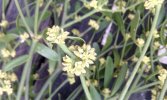
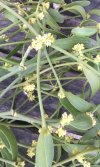
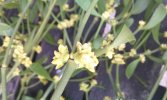
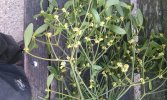
 to find all those excerpts in this one
to find all those excerpts in this one 
